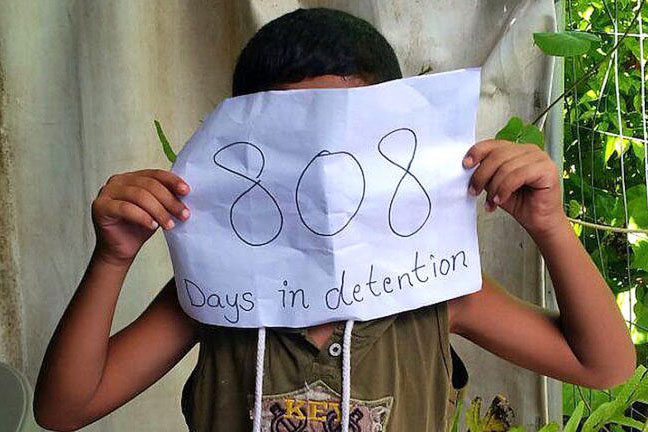At the session I attended, there were only ten other people watching Chasing Asylum. That’s not as it should be; this film’s purposes are everyone’s business. It is centrally concerned with asylum seekers denied admission to Australia and housed in hot, comfortless quarters on Manus Island and Nauru – many children included. These people have been given no hope, not only of coming to Australia, but also of any fixed term to the detention in which they have been held; they have been denied any prospect of change, and any means of moving on. We see men lying around with nothing to do, with no way of acting to improve their situation. The children try to play, but in their drawings the faces have downturned mouths and signs of weeping.
For the film’s courage, the director-producer Eva Orner should be saluted; the project came out of the toughest conditions of production, and often looks as rough as bags, with passages shot on the run, blurred and jerky. Those elements take nothing from its vividness; they rather convey its urgency. Many committed film-workers put time and money into this film, among them Robert Connolly (Balibo), who acted as one of several producers and helped to secure its release.
On Manus, a large, rusting tin shed, left from the second world war, confines a long row of double bunks. Spouses, parents and children are separated; others are forced into proximity with people they don’t know. Visibly, people are damaged, not only by recurrent physical brutality, but just as seriously by forced inertia and boredom. How Horner and her team got into the places, we don’t find out. Journalists and photographers are forbidden entry – a spectacular case of censorship by the Australian government.
The film brings back the uncompromising pronouncement by John Howard during his reign – remember? “We will decide who comes to this country, and the circumstances in which they come.” (I recall some wry comment then on how the inhabitants had no choice when a certain boat turned up in 1788.) The nation’s present policies contravene those UN human rights treaties and conventions to which Australia long ago signed up. It was pronounced as imperative that we must “stop the boats,” boats being somehow more dangerous than planes. Those who supplied the boats, and took money from the asylum seekers, may indeed be classed as criminals; those they’re exploiting are not. With this policy Australia is punishing the innocent – more severely, in fact, than it punishes offenders convicted in the courts, who at least know the limits of their jail terms.
One of the several young witnesses who went to the camps as volunteer social workers said that what she saw made her ashamed to be Australian, a feeling most viewers will share. The film ends with a salute to the late Malcolm Fraser, who enabled the admission of 70,000 asylum-seeking Vietnamese in the 1970s. Many of us didn’t like him much back then; perspectives change.
Chasing Asylum should be seen as widely as possible. Despite the thin attendance, it was some relief to see that at the Nova in Melbourne, six screenings were scheduled for the next day, with an extra at the weekend.
The Sydney Film Festival is in full multiscreen swing, still as ever at the resplendent State, but also scattered across town and out to Casula. The program of restorations and revivals most valuably includes the late Chantal Ackerman’s wonderful Jeanne Dielman, 23 Commerce Quay, 1080 Brussels, and one of the real masterpieces of Japanese cinema, Yasujiro Ozu’s Tokyo Story: not to be missed – this is the kind of thing festivals are, or should be for; but there’s only one screening. •





